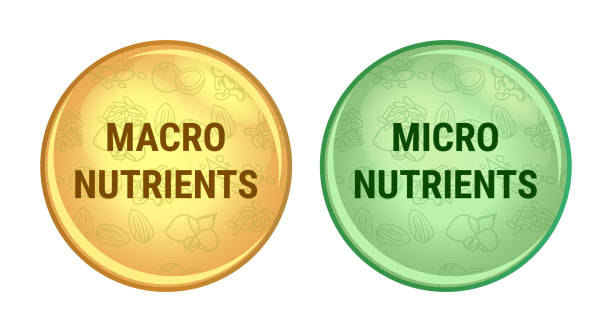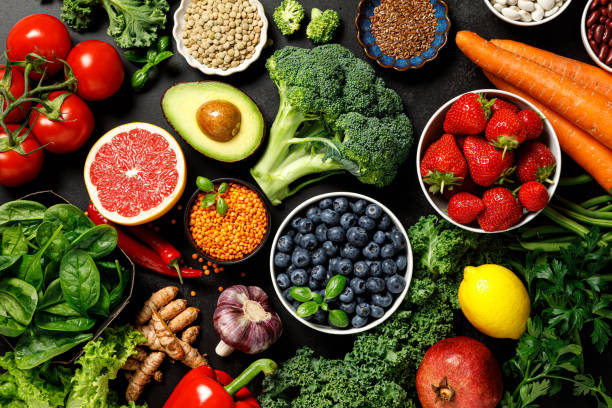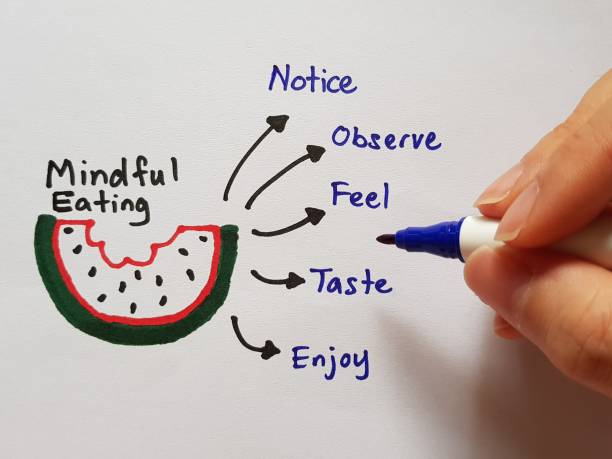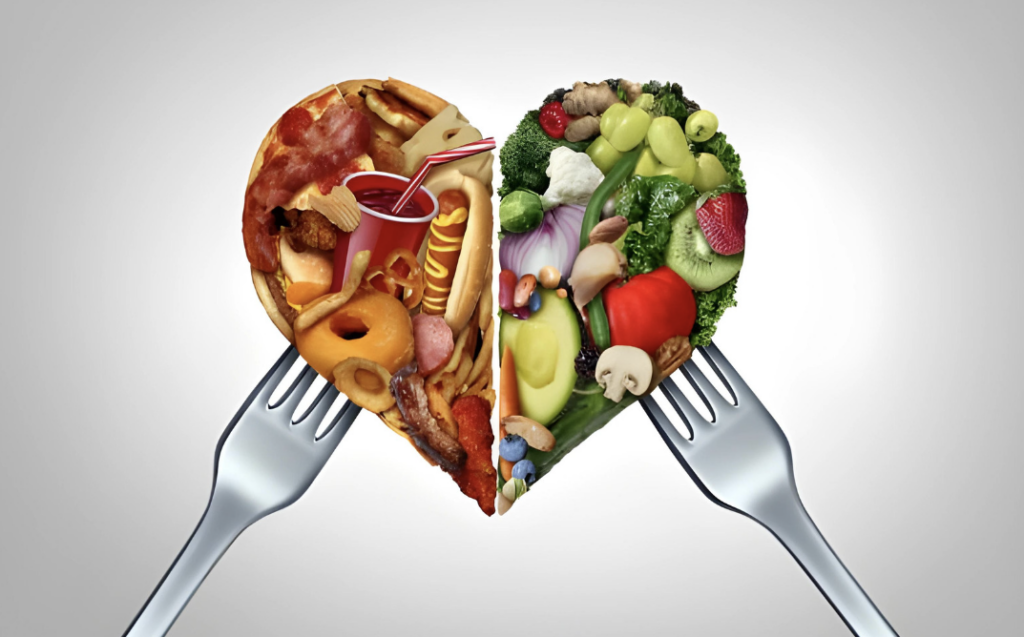What to Eat and Drink
Let’s Dive Deep into What Makes Food Healthy or Unhealthy
Understanding what makes food healthy or unhealthy has never been more crucial in today’s fast-paced world. We are continually bombarded with contradicting information regarding nutrition, making it difficult to determine what is genuinely beneficial to our bodies. However, by looking into the science of food choices, we may make more informed judgments and prioritize our health.
Healthy eating is more than just tracking calories or avoiding certain food groups. It is all about sustaining our bodies with nutrient-dense foods that include critical vitamins, minerals, and antioxidants. bad foods, on the other hand, may contain a lot of sugar, bad fats, or artificial additives, which can cause weight gain, chronic diseases, and a variety of other health problems.
This article will reveal the secrets of what genuinely makes food healthy or unhealthy. We will investigate the effects of various food components, such as carbs, proteins, fats, and micronutrients, on our general health. Understanding the science underlying healthy eating enables us to make better food choices and improve our health. So, let’s plunge in and discover the secrets of a nutritious and balanced diet.
Understanding Nutrients and Their Impact on Health
Understanding the significance of nutrients is essential for assessing whether a food is healthy or unhealthy. Nutrients are nutritional components that provide energy, promote development, repair tissues, and control biological activities. There are two types of nutrients: macronutrients and micronutrients.
Macronutrients
Macronutrients are nutrients that our bodies require in huge quantities to function normally. The three primary macronutrients are carbs, proteins, and lipids. Carbohydrates are the body’s major source of energy, and they can be found in meals including fruits, vegetables, grains, and legumes. Proteins are required for tissue growth and repair and can be found in meat, fish, dairy products, and plant-based sources such as beans and tofu. Although fats are frequently linked with poor health, they are necessary for hormone production, insulation, and the protection of key organs. Avocados, almonds, seeds, and olive oil are all healthy fat sources.
Micronutrients
While macronutrients are required in vast numbers, micronutrients are needed in lower amounts but are just as vital for general health. Micronutrients comprise vitamins and minerals, which are essential for a variety of biological activities. Citrus fruits, for example, include vitamin C, which helps the immune system, whereas dairy products and leafy greens contain calcium, which is needed for bone health. Consuming a diverse range of nutrient-dense foods ensures that our bodies get an adequate supply of essential micronutrients.

The Role of Macronutrients in Determining Food Healthiness
Macronutrients play an important part in deciding whether a food is healthy or unhealthy. However, the quality of these macronutrients is what is truly crucial. Carbohydrates, for example, might be classified as simple or complex.
Simple Carbohydrates
Simple carbs consist of one or two sugar molecules and are readily digested, resulting in a rapid rise in blood sugar levels. Sugary drinks, candy, and processed snacks are examples of simple carbohydrates-rich foods. Overconsumption of simple carbs can cause weight gain, insulin resistance, and an increased risk of acquiring chronic diseases like diabetes.
Complex Carbohydrates
Complex carbohydrates, on the other hand, are composed of three or more sugar molecules and breakdown more slowly, resulting in a consistent release of energy. Whole grains, fruits, vegetables, and legumes are excellent sources of complex carbs. These meals are high in fiber, which improves digestion, promotes satiety, and contributes to stable blood sugar levels. Consuming complex carbs as part of a balanced diet can improve general health and well-being.
Micronutrients and Their Importance in a Healthy Diet
While macronutrients are necessary for energy and physical processes, micronutrients are also critical for sustaining good health. These vitamins and minerals play important roles in many biochemical processes and are required for our bodies to function properly.
Vitamins
Vitamins are chemical molecules that our systems require in little amounts to perform critical tasks. Vitamins are classified into two types: fat-soluble (vitamins A, D, E, and K) and water-soluble (vitamins B and C). Fat-soluble vitamins are stored in the body’s fat tissues and can be found in meals like fatty fish, dairy, and leafy greens. In contrast, water-soluble vitamins are not stored in the body and must be consumed on a regular basis through foods such as fruits, vegetables, and whole grains.
Minerals
Minerals are inorganic compounds that serve important roles in a variety of biological processes. Calcium, iron, magnesium, zinc, and potassium are some of the most significant minerals. Calcium is necessary for bone health and can be received through dairy products, leafy greens, and fortified meals. Iron is required for the formation of red blood cells and can be found in foods such as meat, beans, and fortified cereal. Magnesium is required for hundreds of metabolic activities in the body and can be derived from nuts, seeds, and whole grains. Zinc, which is present in meat, seafood, and legumes, promotes immunological function. Potassium is essential for maintaining fluid balance and can be found in fruits, vegetables, and dairy products.
We can provide our bodies with the micronutrients they require for maximum health by eating a varied and balanced diet rich in fruits, vegetables, whole grains, lean meats, and healthy fats.

Common Misconceptions about Healthy and Unhealthy Food
There are numerous misconceptions about what is healthy or unhealthy in the world of food. Conflicting information, fad diets, and deceptive marketing practices are common causes of these beliefs. It is critical to distinguish fact from fiction and make informed decisions based on credible sources.
Fat-Free and Low-Fat Foods
One prevalent misperception is that fat-free or low-fat foods are always better choices. While cutting out on saturated and trans fats is good for your heart, keep in mind that not all fats are unhealthy. Some fats, including those found in avocados, almonds, and olive oil, are actually helpful to our health. Furthermore, many fat-free or low-fat foods make up for the lower fat content with added sugar or toxic ingredients, which might negate any possible health benefits.
Natural and Organic Foods
Another common fallacy is that natural or organic foods are inherently healthier. While organic foods are free of synthetic pesticides and fertilizers, this does not necessarily imply that they are more healthy. The term “natural” is frequently used informally in food marketing and has no clear definition or regulation. Reading labels and understanding ingredients is critical for making the greatest health decisions.
Superfoods
The concept of superfoods has gained popularity in recent years, with claims that some foods provide tremendous health advantages. While many of these meals are nutrient-dense, keep in mind that no single food can provide all of the nutrients required for good health. A well-balanced and varied diet rich in fruits and vegetables, whole grains, lean proteins, and healthy fats is essential for acquiring a diverse range of nutrients.
By remaining aware and critical of food marketing strategies, we may make better decisions and prioritize our health.

The Impact of Food Processing on Nutritional Value
Food processing has become an essential component of our modern food system. While it adds convenience and extends the shelf life of many foods, it can also affect their nutritional content.
Nutrient Loss
Certain nutrients may be lost or decreased during food processing. For example, heat processing can lower the vitamin C concentration of fruits and vegetables. Furthermore, the refining process removes the nutrient-rich bran and germ from grains, leaving refined grains deficient in fiber, vitamins, and minerals found in whole grains.
Added Ingredients
Sugar, bad fats, and artificial additives are common substances added during food manufacturing. These additives can raise the calorie count, encourage weight gain, and contribute to a variety of health problems including heart disease and obesity. It is critical to study food labels and select less processed foods wherever possible.
Balanced Approach
While it is good to restrict our consumption of severely processed foods, they do not have to be fully eliminated from our diets. Instead, a well-balanced strategy that incorporates both minimally processed foods and cooked meals can help us establish a balance between convenience and nutritional value.

The Role of Portion Sizes in Determining Food Healthiness
In addition to the quality of the food we eat, portion sizes influence whether a food is healthy or unhealthy. Portion sizes have increased over time, resulting in overconsumption of calories and contributing to the obesity epidemic.
Mindful Eating
Mindful eating entails paying attention to hunger and fullness cues, as well as being conscious of portion amounts. It is critical to listen to our body and eat until we are full, rather than overeating in response to environmental cues or emotional triggers.
Portion Control Strategies
There are several ways for portion control. Using smaller dishes and bowls gives the sense of a larger meal, making us feel more content. Additionally, measuring serving sizes, pre-portioning snacks, and being careful of portion sizes when dining out can all help to promote healthier eating habits.
By paying attention to portion sizes and exercising portion management, we can maintain a healthy weight and avoid overeating.

Identifying Healthy and Unhealthy Food Choices
With so many food alternatives available, it can be difficult to determine which ones are nutritious and which are not. However, by learning the basics of healthy eating and reading food labels, we may make better judgments.
Reading Food Labels
Reading the nutrition label is one of the most effective ways to discover how healthy an item is. Pay attention to the serving size, as well as the calorie, fat, sugar, and salt content. Look for foods that are low in added sugars, harmful fats, and sodium but high in fiber, vitamins, and minerals.
Whole Foods vs. Processed Foods
Whole foods are often healthier than overly processed meals. Whole foods consist of fruits, vegetables, whole grains, lean proteins, and healthy fats. They are nutrient-dense, include critical vitamins and minerals, and are frequently low in added sugars, harmful fats, and artificial ingredients.
Moderation is Key
While it is vital to prioritize nutrient-dense foods, indulging in moderation can be part of a well-balanced diet. Instead of fully eliminating particular foods, an 80/20 strategy, in which 80% of the diet is made up of nutritious, whole foods and 20% is left open for flexibility and enjoyment, can help maintain a sustainable and practical approach to healthy eating.

To summarize, understanding what makes food healthy or unhealthy is critical in today’s fast-paced environment. Understanding the influence of macronutrients, micronutrients, food processing, portion sizes, and reading food labels allows us to make informed health-conscious decisions.
Rather than focusing on tight diets or removing entire food groups, it is critical to aim for balance and moderation. A varied and balanced diet rich in nutrient-dense foods, combined with occasional indulgences in moderation, can help us achieve peak health and well-being.
So, the next time you make a food decision, remember to think about the nutrient content, processing techniques, portion sizes, and overall balance. You can start your road to a healthier and more nourishing diet by adopting simple, long-term improvements.
Trusted Health, Wellness, and Medical advice for your well-being


